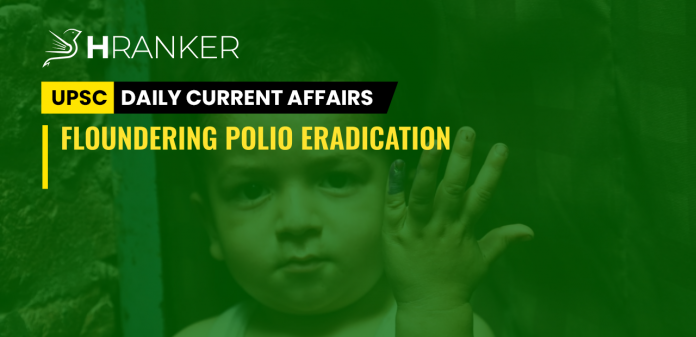WHAT’S IN NEWS:
Recently, cases of wild polio virus (WPV) have re-emerged in different parts of the world with type 1 (WPV1) in Malawi imported from Pakistan and a polio outbreak in Israel caused by circulating vaccine-derived poliovirus type 3 (cVDPV3). These outbreaks are signs of floundering polio eradication programmes which is a danger sign for highly populated countries like India.
POLIO OR POLIOMYLITIS:
- Polio, or poliomyelitis, is a disabling and life-threatening disease caused by the poliovirus.
- The virus spreads from person to person and can infect a person’s spinal cord, causing paralysis (can’t move parts of the body).
- Poliovirus only infects people. It enters the body through the mouth and spreads through: 1. Contact with the feces (poop) of an infected person 2. Droplets from a sneeze or cough of an infected person (less common)
- Common symptoms of the disease include sore throat, fever, tiredness, nausea, headache, stomach pain while severe symptoms include Paresthesia, Meningitis and Paralysis.
- There are three wild types of poliovirus (WPV) – type 1, type 2, and type 3. People need to be protected against all three types of the virus in order to prevent polio disease and the polio vaccination is the best protection.
There are two types of vaccines that are used to prevent the spread of polio virus:
- Inactivated poliovirus vaccine (IPV) given as an injection in the leg or arm, depending on the patient’s age. Only IPV has been used in the United States since 2000.
- Oral poliovirus vaccine (OPV) is still used throughout much of the world. It is administered orally as polio drops.
- After wild poliovirus type 2 was declared eradicated in 2015, the world switched from trivalent to bivalent OPV (bOPV). Trivalent OPV contains all three types of poliovirus, while bOPV only contains poliovirus type 1 and 3. This switch means that OPV no longer protects against WPV2.
Circulating vaccine-derived poliovirus (cVDPV):
The oral polio vaccine (OPV) that has brought the wild poliovirus to the brink of eradication has many benefits: the live attenuated (weakened) vaccine virus provides better immunity in the gut, which is where polio replicates. The vaccine virus is also excreted in the stool, and in communities with low-quality sanitation, this means that it can be spread from person to person and actually help protect the community.
However, in communities with low immunization rates, as the virus is spread from one unvaccinated child to another over a long period of time (often over the course of about 12-18 months), it can mutate and take on a form that can cause paralysis just like the wild poliovirus. This mutated poliovirus can then spread in communities, leading to cVDPVs.
In Israel, cVDPV emerged and caused an outbreak. Only seven children were paralysed, all unvaccinated. The risk of paralysis from WPV-3 is 1 in 1000 infected children but due to Israel low population, lesser number of infections were registered.
INDIAN CONTEXT AND WORRYING SIGNS:
India conducts one annual national and two sub-national pulse immunisation campaigns with bivalent (type 1 and type 3) OPV (bOPV) for all children below five years, in addition to routine immunisation with five doses- totalling 10 to 15 doses per child in different states.
The probaility of cVDPV outbreak is low in India but on account of our population size of 140 million, its impact is likely to enormous. India must withdraw type 3 and continue monovalent type 1 OPV, which also must be withdrawn after reaching 85-90% coverage with IPV, three doses per child.
Parallely, India should also think about switching to IPV mode of vaccination which is used in immunisation in most rich countries as it is free from all the safety considerations that are there with OPV. The low cost of OPV could be fallacious. There is no such analysis to prove that the overall cost could be less for 10-15 doses of OPV, including campaigns than IPV given through Universal Immunisation Programme (UIP).
| HISTORY OF POLIO ERADICATION CAMPAIGNS: 1. The eradication target, when launched in 1988 was 2000 as a gift of twentieth century to twenty-first century. The World Health Organisation assumed the task for its implementation. 2. Rotary International launched its ‘Polio Plus’ project in 1985 to provide polio vaccines to under-five children of all developing countries before 2005. Of the six WHO regions, three – Americans, Europe and Western Pacific had already independently resolved to eradicate polio in their territories by or before 2000. 3. WHO’s task was essentially confined to the ‘Southern Arc’ of the remaining regions – Africa, Eastern Mediterranean and South East Asia. 4. Having failed the target of 2000, WHO revised it every 4-5 years. Now it is 2026. |




